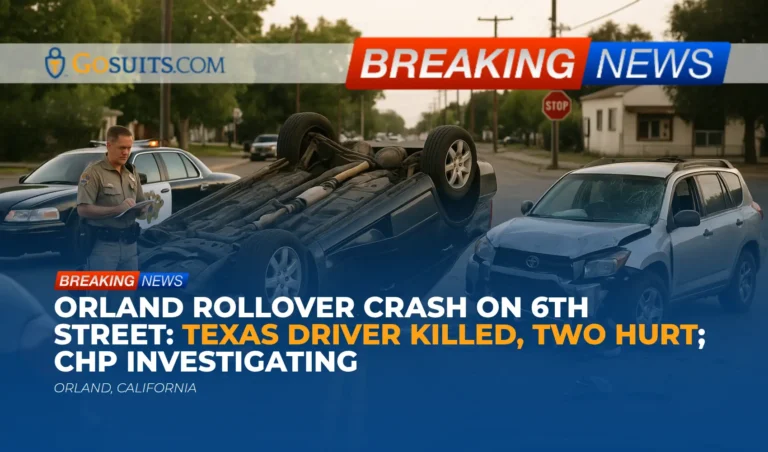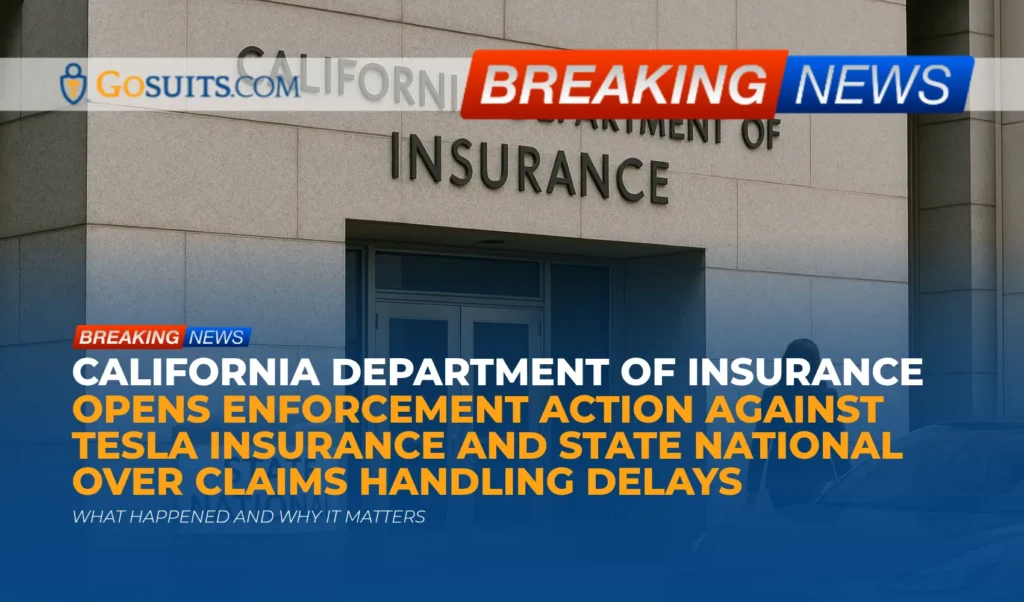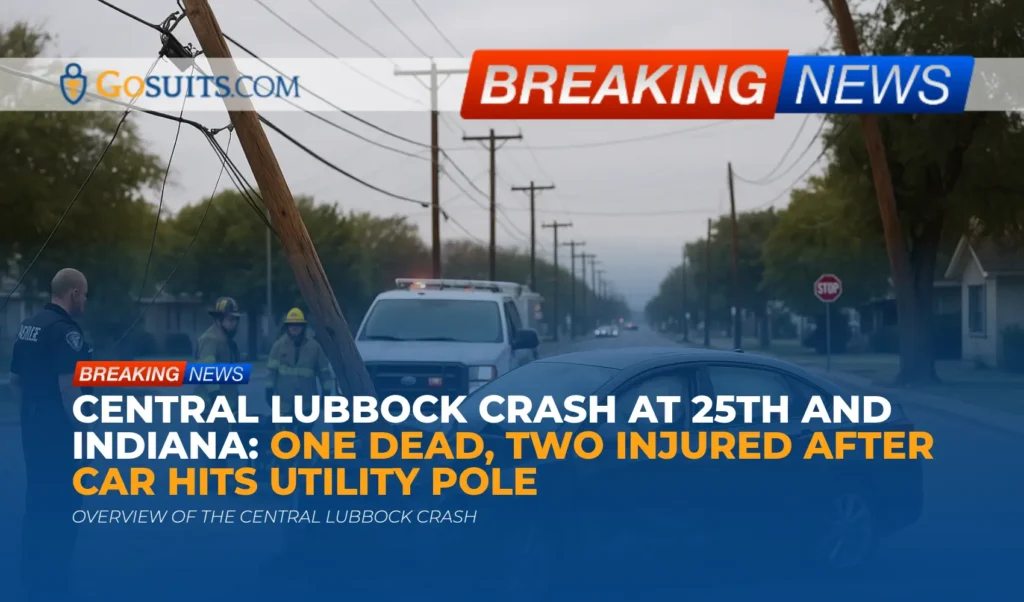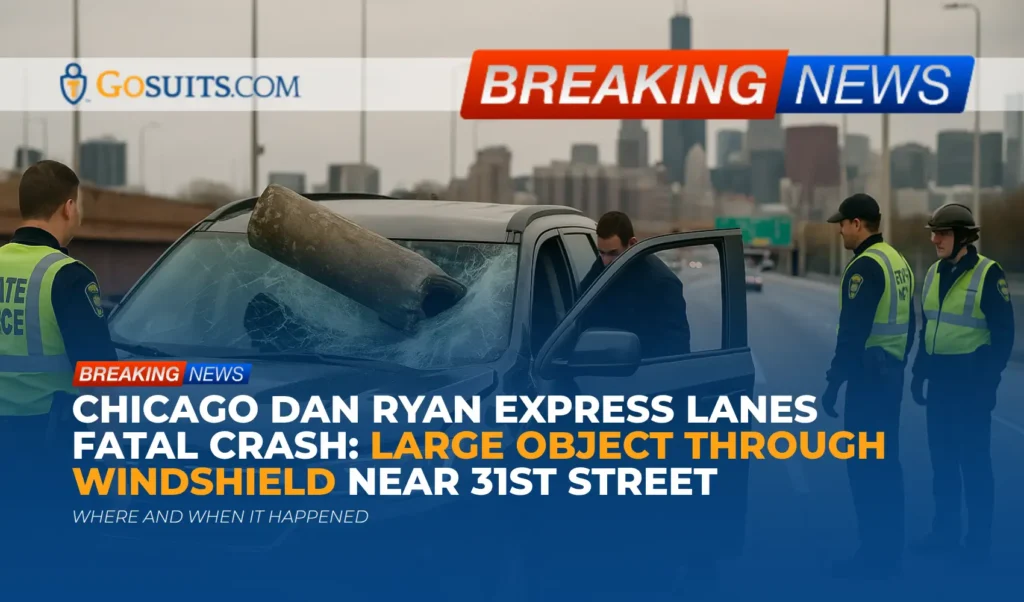- Overview of the Orland rollover crash
- Known facts from CHP
- How crash investigations work and what evidence matters
- Safety and legal context in California
- Potential civil liability and insurance pathways
- How to obtain official records and reports
- Practical steps to protect rights after a serious crash
- Time limits and deadlines in California
- Helpful contacts and public resources
- Commentary from Gosuits Orland, California Personal Injury Attorney
- Why timely action matters now
Overview of the Orland rollover crash
Authorities are investigating a multi-vehicle crash in Orland, California that occurred on a Thursday afternoon and ended in a fatality. According to the California Highway Patrol (CHP), a 66-year-old man from Texas was driving a Chevrolet south on 6th Street when, for reasons not yet known, the Chevrolet accelerated into the rear of a Toyota. The Toyota was driven by Seth Hodgson, 35, with passenger Whitney Urmann, 30, both from the Forest Ranch area. The impact led to both drivers losing control, and both vehicles overturned. The Texas driver was not wearing a seat belt and suffered fatal injuries at the scene. CHP reported that Hodgson and Urmann sustained minor injuries. The name of the deceased driver is being withheld pending family notification.
This article summarizes what is publicly known, explains how crash investigations typically proceed, and outlines practical next steps for obtaining official records, preserving evidence, and understanding general civil legal considerations in California. It is written with care and respect for everyone affected.
Known facts from CHP
What happened
CHP reports that a southbound Chevrolet on 6th Street accelerated into the rear of a Toyota, causing both drivers to lose control and overturn. A rollover can occur when a vehicle’s balance and lateral stability are disrupted by impact forces; once a vehicle trips or rotates, momentum can carry it over.
Who was involved
CHP identified the Toyota’s driver as Seth Hodgson, age 35, and the passenger as Whitney Urmann, age 30, both from the Forest Ranch area. The Chevrolet’s driver was a 66-year-old Texas resident whose name has not been released pending notification of next of kin. CHP stated that the Chevrolet driver was not wearing a seat belt. Hodgson and Urmann experienced minor injuries; the Chevrolet driver suffered fatal injuries.
Where and when
The collision occurred on 6th Street in Orland, California, on a Thursday afternoon. Specific time and block location were not included in the initial report available.
Status of the investigation
CHP has opened an investigation. As with most serious collisions, the agency will likely develop a traffic collision report that includes a diagram, statements, roadway measurements, evidence photos, and, where applicable, a reconstruction analysis. The preliminary observation that the Chevrolet “accelerated into the back” of the Toyota is not a final fault determination; investigators often review multiple evidence sources before reaching findings.
How crash investigations work and what evidence matters
In California, major-injury and fatal crashes generally trigger detailed scene documentation. The process can include:
- Scene measurements and diagrams: skid and yaw marks, debris fields, rest positions, roadway conditions, and sightlines.
- Vehicle inspections: damage profiles, airbag control module data (also called event data recorder or EDR), restraint use indicators, and mechanical condition.
- Witness statements: from involved parties and independent witnesses.
- Environmental factors: weather, lighting, and potential roadway hazards.
Some modern vehicles store limited pre-crash data, such as speed, throttle position, brake application, and seat belt status in the moments before impact. Preserving vehicles in their post-crash condition can be important if EDR data may be relevant. Federal regulations address EDR standards for certain vehicles; more information about EDRs is available from the National Highway Traffic Safety Administration (nhtsa.gov).
If a fatality occurs, the county medical examiner-coroner typically conducts an investigation to determine cause and manner of death. That can include an autopsy, toxicology testing, and review of medical history. The findings become part of official records and may be requested by legally authorized individuals.
Safety and legal context in California
Rear-end impacts and following distance
While CHP is still investigating the Orland crash, California law requires drivers to maintain a safe following distance and speed for conditions. The California Vehicle Code prohibits following another vehicle more closely than is reasonable and prudent, having due regard for the speed of such vehicle and traffic conditions (Veh. Code § 21703). The basic speed law similarly requires that no person drive at a speed greater than is reasonable or prudent given weather, visibility, traffic, and road surface conditions (Veh. Code § 22350).
A rear-end collision does not automatically assign fault, but the duty to control speed and following distance is a frequent focus in these investigations. Mechanical failure, sudden and unexpected hazards, or other factors can also be examined by investigators.
Seat belts and rollover risk
Seat belt use is required for drivers and adult passengers in California (Veh. Code § 27315). In rollover crashes, unrestrained occupants face a significantly increased risk of ejection. National Highway Traffic Safety Administration research notes that unbelted occupants are far more likely to be ejected, and ejection is associated with a much higher risk of fatal injury. NHTSA’s safety materials consistently emphasize that seat belts are the most effective protection in a crash (nhtsa.gov).
Large-scale public health data reinforce this point. The Centers for Disease Control and Prevention reports that proper seat belt use reduces the risk of death and serious injury in motor vehicle crashes (cdc.gov). While investigators will evaluate all circumstances of this crash, restraint use is a factor commonly analyzed in injury severity.
Comparative fault in California
California applies comparative fault principles in civil cases, which means a person’s compensation can be reduced in proportion to their percentage of responsibility for the harm. The Judicial Council’s civil jury instructions address comparative fault assessments (courts.ca.gov; see CACI series on negligence and comparative fault). This framework is sometimes relevant where multiple factors contributed to injuries, such as driving behaviors, environmental conditions, or restraint non-use.
Potential civil liability and insurance pathways
Injury claims for the Toyota occupants
When someone is injured in a crash caused by another driver’s conduct, they may have a claim against that driver’s insurance for medical bills, lost income, pain and suffering, and other legally recognized damages. The preliminary facts reported by CHP indicate that the Chevrolet accelerated into the rear of the Toyota, after which both vehicles overturned. If further investigation supports that the Chevrolet driver was negligent, the Toyota’s driver and passenger may pursue third-party injury claims against the Chevrolet driver’s liability insurance.
Because injuries were described as minor, medical documentation remains important. Even seemingly modest injuries can involve ongoing symptoms that may not be apparent immediately. Early evaluation, diagnosis, and consistent follow-up create a clearer medical picture.
Wrongful death considerations for the deceased driver’s family
When a fatality occurs, surviving family members may explore potential wrongful death claims depending on the circumstances. These claims can arise in many scenarios, including where another party’s negligence contributed to the crash. Determining whether any third party bears civil responsibility requires a careful, evidence-based review of the collision dynamics, possible vehicle defects, roadway factors, or other contributing conditions. It is important not to assume outcomes before the investigation is complete.
Uninsured/underinsured motorist coverage
If the at-fault driver lacks sufficient insurance to cover losses, injured people may be able to use their own uninsured/underinsured motorist (UM/UIM) coverage, depending on the policy. California motorists are required to maintain financial responsibility, and the Department of Motor Vehicles provides information on minimum coverage requirements and financial responsibility laws (dmv.ca.gov). Policy terms and notice requirements vary, so prompt review can be useful.
Property damage and total loss
Rollover impacts often cause extensive vehicle damage. Property damage claims typically involve vehicle repair or total loss valuation, diminished value in some cases, and rental or loss-of-use. Documenting pre-crash condition, mileage, maintenance, and aftermarket additions can help the valuation process. If there are disputes, appraisal and review procedures are often outlined in the policy.
Communicating with insurers
Insurance adjusters may request recorded statements soon after a collision. Statements made early can be used in evaluating fault and damages. It is prudent to consult an attorney before speaking with any insurance company about the facts of the crash. Even with one’s own insurer, providing only required basic information until after legal guidance can reduce the risk of misunderstandings. What is said to an insurer can be used against the claimant later.
How to obtain official records and reports
CHP traffic collision report
CHP collision reports can typically be requested using the “Request for CHP Collision Report” (CHP 190) form. The California Highway Patrol provides instructions and the form on its website (chp.ca.gov). Requesters must generally be a party to the collision, a guardian, a parent of a minor involved, or a legal representative. The report will include the officer’s narrative, diagram, involved parties, and, where relevant, supplemental pages.
Death certificate and coroner records
For a fatality, immediate next of kin may seek a certified death certificate from the California Department of Public Health’s Vital Records office (cdph.ca.gov). Autopsy and coroner investigative reports are typically obtained through the county medical examiner-coroner for the county where the death occurred. Authorization rules vary by county and by the requester’s relationship. General guidance on the role of medical examiner-coroner investigations is available through public health resources such as the CDC (cdc.gov).

Emergency medical services and hospital records
Ambulance run reports and hospital records can be requested by the patient or authorized representative under federal privacy rules. The U.S. Department of Health and Human Services explains patient rights to access health records under HIPAA (hhs.gov). Request these promptly; accurate and complete medical documentation is central to any injury evaluation.
DMV report of traffic accident (SR-1)
California requires a Report of Traffic Accident Occurring in California (SR-1) to be filed with the DMV within 10 days if anyone was injured or killed, or if property damage exceeds the statutory threshold. The DMV provides the SR-1 form and instructions (dmv.ca.gov). Filing the SR-1 is separate from the police report and insurance claim. It is wise to consult an attorney before submitting narrative descriptions because statements can have downstream effects.
Other evidence to preserve
Where feasible:
- Photograph vehicles, roadway marks, debris, and resting positions as soon as practical.
- Retain dashcam footage or nearby surveillance clips.
- Preserve vehicles until they can be inspected; do not authorize disposal if potential claims are being evaluated.
- Consider EDR data preservation for vehicles that store crash metrics; consult qualified professionals for retrieval in a forensically sound manner (see NHTSA EDR resources, linked above).
Practical steps to protect rights after a serious crash
Seek thorough medical evaluation
Prompt care matters. Some injuries are not immediately obvious, especially after a rollover or high-energy impact. Follow up with primary care or a specialist as recommended. Keep copies of all medical records, imaging, prescriptions, and referrals.
Organize documentation
Start a file with the claim number, adjuster contact information, repair estimates, photographs, wage-loss documentation, and out-of-pocket receipts. Consistent recordkeeping helps avoid delays and confusion.
Avoid early recorded statements
Insurance companies often ask for recorded statements quickly. Because those statements can influence fault decisions and damages assessments, getting legal guidance first can be protective. What is said to an insurance company can be used later in the process.
Do not rush repairs or disposal
In significant collisions, the vehicle itself is evidence. If a defect, restraint issue, or other mechanical factor is suspected, preserving the vehicle for inspection can be critical. Towing and storage fees can accrue, so coordinate early with insurers and, if applicable, legal counsel to manage inspections efficiently.
Consider emotional health
Crashes with severe outcomes can be emotionally difficult. Seeking support through primary care, counseling, or community resources may help with recovery. Documenting mental health impacts can also be relevant to a complete understanding of harm.
Time limits and deadlines in California
California’s general statute of limitations for personal injury and wrongful death is two years from the date of the injury or death (Code Civ. Proc. § 335.1). Some claims, including those against public entities, may require a government claim to be filed within six months of the incident (Gov. Code § 911.2). Other deadlines apply for insurance notice, UM/UIM claims, and contractual provisions.
Because exceptions and special rules exist, early review of the timelines can prevent rights from expiring unexpectedly.
Helpful contacts and public resources
California Highway Patrol
- Collision reports: Request through the CHP 190 process and instructions at chp.ca.gov.
- Local office information: CHP provides an office locator and contact information on its site to assist in directing requests.
California Department of Public Health – Vital Records
- Death certificates: Instructions and forms at cdph.ca.gov.
County medical examiner-coroner
- Autopsy and investigative reports: The county medical examiner-coroner where the death occurred handles these records. Authorization is typically limited to next of kin or legal representatives. General information on death certification processes is available from the CDC at cdc.gov.
California DMV
- SR-1 accident reporting requirement: See dmv.ca.gov.
- Financial responsibility and insurance basics: See dmv.ca.gov.
Vehicle safety and seat belt information

Commentary from Gosuits Orland, California Personal Injury Attorney
Our hearts go out to everyone affected by this crash and to the family of the Texas driver whose life was lost. We also wish a steady recovery to Mr. Hodgson and Ms. Urmann. The information here is intended for educational purposes and general awareness and should not be treated as guidance for any particular person or situation.
Based on what CHP has shared so far, this appears to have been a high-energy rear-end collision that led to both vehicles overturning. Investigators will examine the Chevrolet’s acceleration into the Toyota, the role of following distance and speed, and any other contributing factors. In a rollover, seat belt use can be the difference between survivable injuries and catastrophic harm; that is why restraint analysis is a standard part of crash investigations. Even so, it is important to let the full investigative process run its course before drawing conclusions about civil responsibility.
In our experience, insurers and large corporations often move quickly after an incident to shape the narrative. Claims representatives may seek recorded statements, ask for broad medical authorizations, or press for early settlements before the full scope of injuries or losses is clear. People are typically unfamiliar with how these statements and documents might be used later to minimize or question a claim. Understanding one’s rights before engaging with insurance companies can help prevent avoidable missteps.
A no-cost initial consultation with a seasoned injury attorney can provide clarity about next steps, time limits, and evidence preservation. It can also help individuals understand what to say and what not to say to insurers. Early guidance often makes the process more manageable during an already difficult time.
Why timely action matters now
What to do
- Obtain the official CHP collision report and any supplemental documents through the CHP 190 process.
- Organize medical care and keep complete records of evaluations, imaging, prescriptions, and follow-up appointments.
- Preserve all physical and digital evidence, including vehicle access for inspection, photographs, and any available dashcam or nearby surveillance footage.
- Review insurance policies promptly, including UM/UIM coverage and medical payments provisions, and note any notice requirements.
- Consult a qualified attorney before providing recorded statements or broad authorizations to any insurer. Anything said can be used later in the claim process.
- Calendar critical deadlines, including the DMV SR-1 filing within 10 days when required, and the civil statutes of limitation.
Why it matters
- Evidence can disappear quickly. Vehicles may be moved or destroyed, electronic data overwritten, and roadway marks fade; early preservation enables a more accurate reconstruction of what happened.
- Medical documentation is strongest when timely and consistent. Gaps in care or delayed evaluation can be used to question the relationship between injuries and the collision.
- Insurers begin evaluating fault and damages almost immediately. Accurate, measured communication and when appropriate, deferring statements until after obtaining legal guidance can help avoid misunderstandings that are hard to correct later.
- Legal deadlines are strict. Missing a filing deadline can end a claim regardless of its merits.
When to act
- Within days: Request the collision report, file the DMV SR-1 if required, photograph vehicles and the scene, and secure any available video evidence.
- Within weeks: Complete initial medical follow-up, compile insurance information, and assess whether expert evaluation of vehicles (including potential EDR data) is needed.
- Before key deadlines: Track the two-year statute for injury or wrongful death claims and the six-month claim deadline for any public entity issues that may arise, understanding that exceptions and special circumstances may apply.
Acting steadily and thoughtfully without rushing to accept quick settlements or providing broad recorded statements helps protect the ability to make informed decisions once the investigation is complete and the medical picture is clearer.






